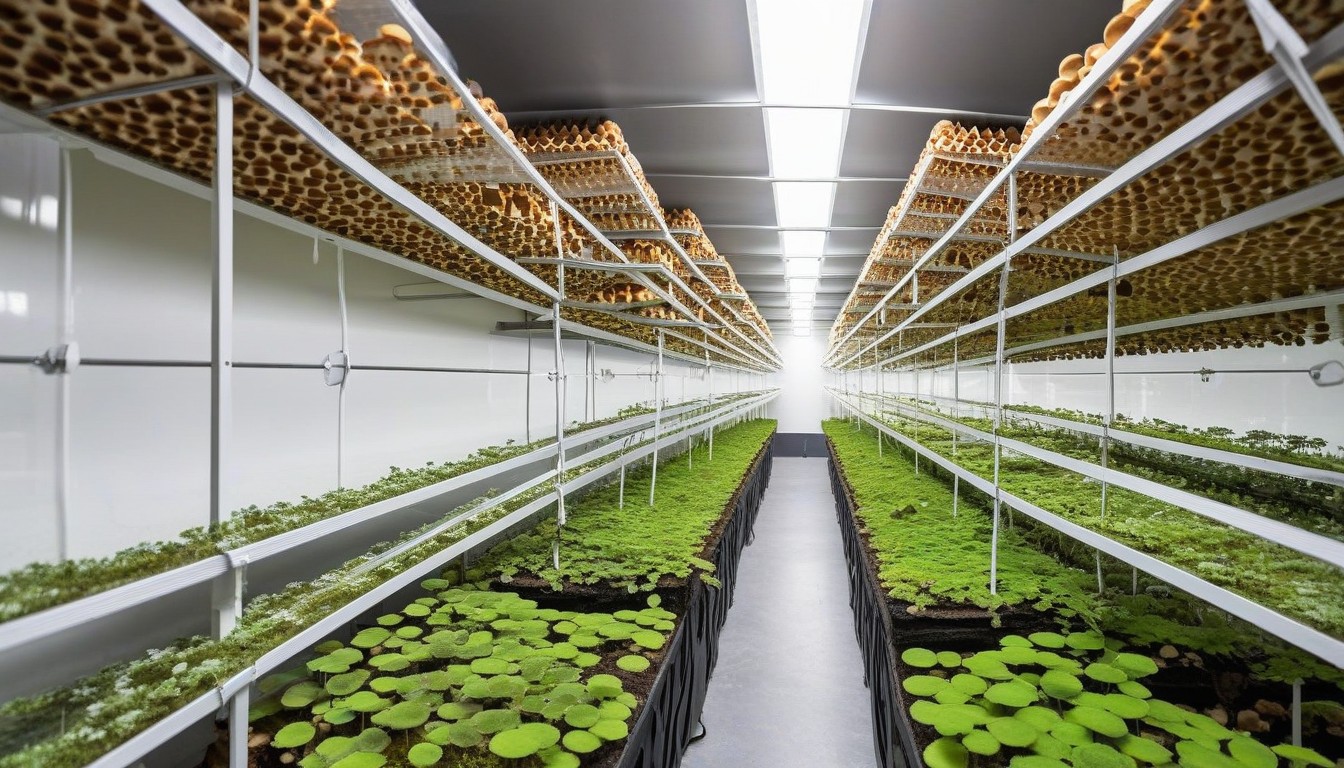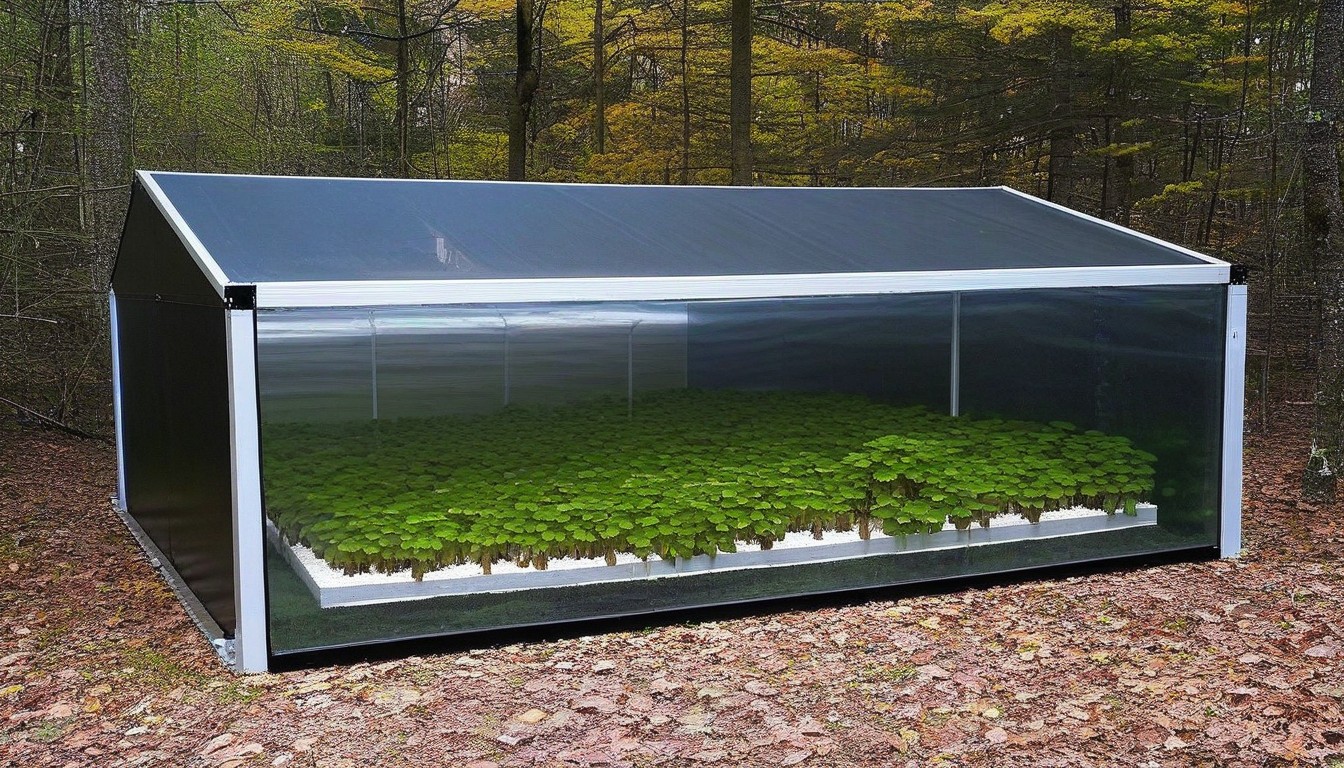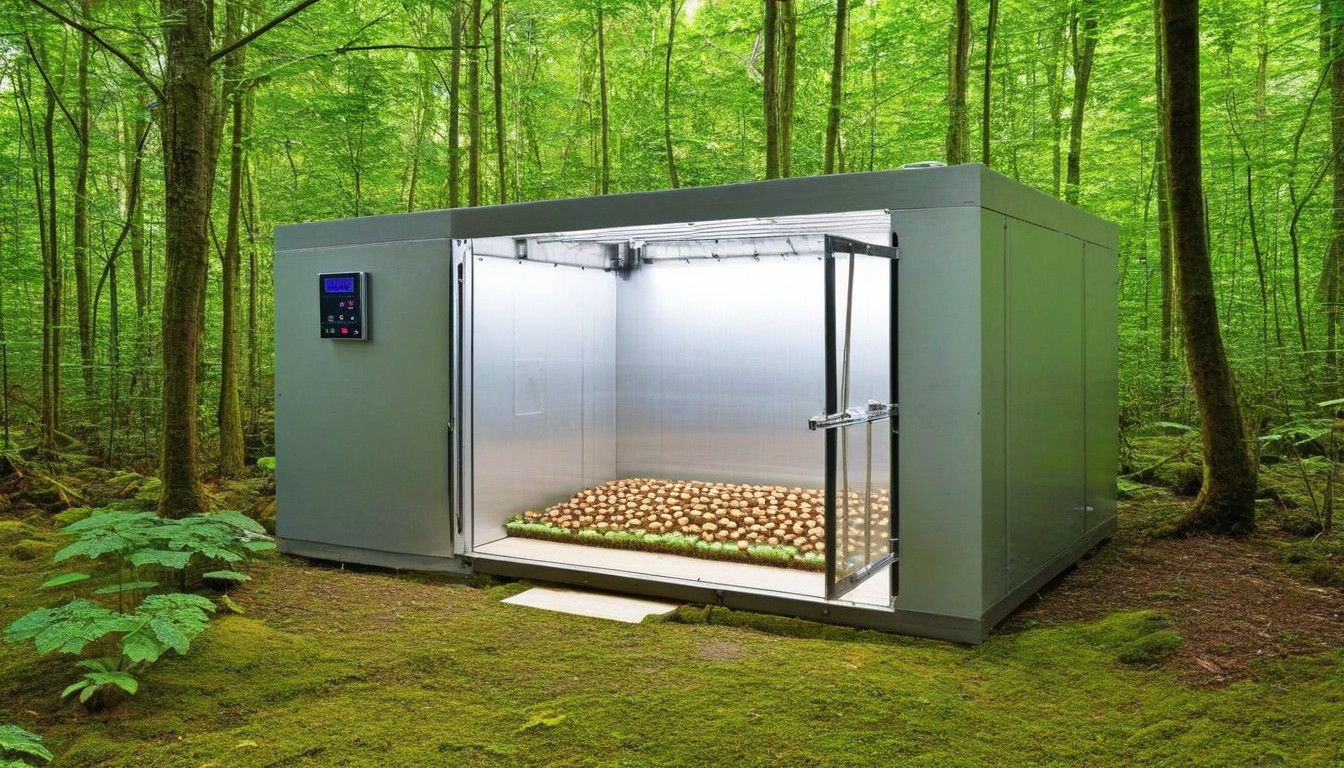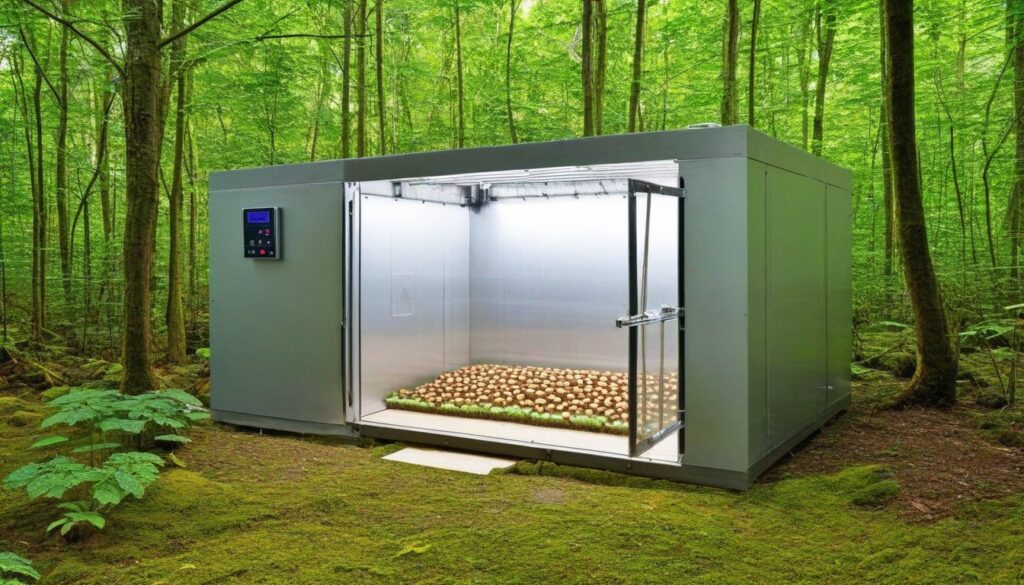Welcome to our comprehensive guide on the benefits of an efficient incubation chamber for mushrooms. As a mushroom cultivator, you know that creating the ideal environment for incubation is essential for a successful harvest. That’s why investing in a specialized incubation chamber can help maximize your mushroom yield by providing optimal conditions for incubation.
In this guide, we will cover everything you need to know about choosing, setting up, and maintaining an incubation chamber for mushrooms. From understanding the incubation process to troubleshooting common issues, we’ve got you covered.
Key Takeaways:
- Investing in an incubation chamber can help maximize mushroom yield.
- Choosing the right mushroom strain is essential for successful incubation.
- Consistency in temperature, humidity levels, and air circulation is key for optimal mushroom growth.
- Maintaining and cleaning the incubation chamber is essential for longevity and efficiency.
- Harvesting and transferring to the fruiting chamber requires proper technique for a bountiful harvest.
Understanding Mushroom Incubation
Before delving into the details of an incubation chamber, it is essential to understand the mushroom incubation process. Mushroom incubation refers to the controlled environment where mycelium, the vegetative growth stage of the mushroom, colonizes the growth medium. This colonization process sets the stage for the mushroom fruiting stage, where the mushroom produces the edible fruiting body that we consume.
Mushroom incubation is a crucial stage as it determines the quality and quantity of the crop. Adequate temperature, humidity, and air exchange are crucial for optimal growth. Temperature affects the speed of growth, while humidity prevents the growth medium from drying out, and air exchange provides an adequate supply of fresh air.
The growth time and conditions depend on the mushroom strain and the growth medium. Once the growing medium is colonized with mycelium, the mushroom is ready for fruiting, where it produces the mushroom fruiting body.
Fun Fact: Shiitake mushrooms are known for their high nutritional value, low-calorie content, and multiple health benefits. They are also one of the easiest species for beginners to cultivate, making them a popular choice for mushroom growers.
The Importance of an Incubation Chamber
If you are serious about cultivating mushrooms, then investing in a dedicated incubation chamber is essential. Not only does it help create optimal conditions for mushroom growth, but it also provides protection against contamination.
With an incubation chamber, you can regulate temperature, humidity levels, and air circulation to ensure that mushrooms receive the best possible environment for growth. Additionally, you can prevent the growth of unwanted bacteria or mold, which can hinder mushroom growth and lead to crop failure.
Increased Yield and Quality
By using an incubation chamber, you can significantly increase the yield and quality of your mushrooms. The controlled environment allows you to create the ideal conditions for growth, resulting in faster and more consistent growth rates. This means you can produce larger quantities of mushrooms in a shorter amount of time, maximizing your profits and efficiency.
Protection against Contamination
Contamination is one of the biggest challenges faced by mushroom growers. It can occur at any stage of the cultivation process and can severely affect crop yield and quality. However, with an incubation chamber, you can significantly reduce the risk of contamination.
The chamber provides a sealed and sterile environment that is difficult for bacteria or fungi to penetrate, lowering the risk of contamination. Moreover, the chamber allows you to control the levels of carbon dioxide, oxygen, and humidity to create the perfect environment for mushroom growth while preventing the growth of unwanted organisms.
Improved Efficiency
Investing in an incubation chamber can also help improve your overall efficiency as a mushroom grower. With a dedicated chamber, you can easily monitor and adjust the environment to ensure optimal growth conditions. This allows you to spend less time monitoring your mushrooms and more time focusing on other aspects of your business, such as marketing and sales.
Moreover, the controlled environment of an incubation chamber means that you can grow mushrooms all year round, regardless of the weather conditions outside. This eliminates the need to rely on natural weather conditions and allows you to produce a consistent supply of high-quality mushrooms.
Key Features to Look for in an Incubation Chamber

Investing in an incubation chamber for mushroom cultivation can significantly improve your harvest. However, not all incubation chambers are created equal. There are several features to consider when choosing the right one for your needs.
Temperature control options
One of the most important features an incubation chamber can offer is precise temperature control. Different types of mushrooms require different temperature ranges for optimal growth, so make sure the chamber you select has the capability to maintain the temperature range required for your chosen strain(s). Some incubation chambers include built-in temperature control systems, while others require external heating or cooling sources.
Humidity regulation
Mushrooms thrive in environments with high humidity levels, so a reliable humidity control system is another important feature to look for. A constant humidity level of around 80-90% is optimal for incubation. Look for a chamber with a built-in humidifier or one with a design that allows for easy control of humidity levels.
Ventilation systems
Ventilation is crucial for maintaining adequate oxygen levels and preventing the build-up of harmful gases. Look for a chamber with a ventilation system that provides ample air circulation while also preventing contaminants from entering the chamber.
Shelving design
The design of the shelving within the incubation chamber can significantly impact the efficiency of the space. Look for a chamber with adjustable shelving that can accommodate a variety of mushroom growth stages and allow for easy access to all areas of the chamber.
Size
The size of the incubation chamber is another important consideration. Make sure to select a chamber that is large enough to accommodate your desired mushroom yield, but also small enough to fit in the space you have available and operate efficiently.
Materials
The materials used to construct the chamber can impact its durability and longevity. Look for a chamber made with high-quality, durable materials that are safe for mushroom growth and resistant to corrosion and contamination.
Take the time to research and compare the features of different incubation chambers before making a purchase. By selecting a chamber with the right features, you can create the ideal environment for successful mushroom incubation.
Setting Up the Incubation Chamber
Now that you have selected the right incubation chamber for your mushroom strains, it’s time to set it up for optimal growth. Follow these step-by-step instructions to ensure proper installation and configuration.
Preparing the Chamber
- Choose a clean and dry area to set up the chamber.
- Assemble the equipment according to the manufacturer’s instructions.
- Clean the chamber thoroughly with a mild detergent to remove any dirt and dust.
- Wipe the chamber dry with a clean, lint-free cloth or paper towel.
Temperature and Humidity Settings
Proper temperature and humidity are essential for successful incubation. Follow these guidelines to adjust the settings:
- Read the manufacturer’s instructions to determine the optimal temperature and humidity range for your mushroom strains.
- Monitor the chamber’s thermometer and hygrometer to ensure the desired settings are maintained.
- Adjust the settings as needed, using the chamber’s controls.
Clean and Sterile Environment
Contamination can impede mushroom growth and reduce yield. To create a clean and sterile environment:
- Wash your hands thoroughly before handling equipment or mushrooms.
- Wear gloves and a face mask to prevent contamination from your skin and breath.
- Sterilize any equipment that will come into contact with the mushrooms, such as scissors or knives.
- Use a disinfectant spray or solution to clean the chamber’s interior surfaces before introducing the mushrooms.
Air Circulation
Proper air circulation can help prevent the growth of mold and other contaminants. Follow these suggestions to improve air flow:
- Ensure that the chamber is adequately ventilated using the built-in vents or an external fan.
- Place the chamber in a well-ventilated room, away from other sources of moisture and pollutants.
Summary
By following these steps, you can set up an optimal incubation chamber for your mushroom strains. Remember to maintain the ideal temperature, humidity, and air flow, and to create a clean and sterile environment to prevent contamination. With proper care and attention, your mushrooms will thrive and grow, providing a bountiful harvest.
Choosing the Right Mushroom Strains for Incubation

Choosing the right mushroom strains for incubation is essential to ensure a bountiful harvest. Different strains require specific conditions for successful growth, making it important to find the right match for your incubation chamber.
Some popular mushroom strains for incubation include:
|
Mushroom Strain |
Preferred Temperature Range |
Preferred Humidity Range |
|---|---|---|
|
65-75°F (18-24°C) |
85-95% | |
|
Shiitake Mushrooms |
75-81°F (24-27°C) |
85-90% |
|
Button Mushrooms |
55-60°F (13-16°C) |
85-90% |
It’s important to research the specific requirements of each strain before beginning the incubation process. Temperature and humidity levels should be adjusted accordingly to ensure optimal growth.
Tip: Consider starting with a beginner-friendly strain, such as oyster mushrooms, to gain experience with the incubation process before moving on to more challenging strains.
Maintaining the Ideal Environment
Keeping the ideal environment is crucial for successful mushroom incubation. Consistency is key when it comes to maintaining the right temperature, humidity levels, and air circulation within your incubation chamber. Any fluctuations or inconsistency may lead to slow growth or contamination, ultimately resulting in a lower yield.
Temperature: The optimal temperature range for mushroom incubation varies depending on the strain. Generally, temperatures between 65-75°F are ideal. Use a thermometer to monitor the temperature and adjust it accordingly if necessary.
Humidity: Mushrooms thrive in humid environments, so it’s important to maintain the right levels. The recommended humidity range for incubation is between 80-95%. Use a hygrometer to monitor the humidity level and adjust it as needed. Keep in mind that a lack of humidity can lead to slow growth, while excess humidity can promote mold growth.
Air Circulation: Proper air circulation is essential for preventing contamination and providing oxygen for mushroom growth. Make sure your incubation chamber has sufficient ventilation to allow for proper air exchange. If necessary, use a fan or air filter to improve circulation.
Regularly check the environment within your incubation chamber to ensure that it remains stable. Make adjustments as needed to maintain the optimal conditions for your mushroom growth.
Troubleshooting Common Issues in Incubation
Despite your best efforts, issues may arise during the incubation process. It’s essential to be aware of common problems that can occur, such as mold, contamination, and slow growth, and find effective solutions to overcome these challenges. Here are some tips for troubleshooting common incubation issues:
Mold
Mold is a common problem that can occur during mushroom incubation. It usually appears as a white or green fuzz on the substrate. To prevent mold growth, make sure to thoroughly sterilize the incubation chamber and tools before use. If mold does appear, remove the affected substrate immediately to prevent further contamination. Adjusting the temperature and humidity levels can also help to prevent mold growth.
Contamination
Contamination can occur if the incubation chamber or tools are not properly sterilized. It can appear as a foul odor or unusual color on the substrate. To prevent contamination, make sure to sterilize all equipment thoroughly before use. If contamination does occur, remove the affected substrate immediately to prevent further spread. Adjusting the temperature and humidity levels can also help to prevent contamination.
Slow Growth
Slow growth can be caused by a variety of factors, including incorrect temperature or humidity levels, inadequate air circulation, or poor quality substrate. Ensure that the incubation chamber is set to the correct temperature and humidity levels for the specific mushroom strain. Make sure to also provide adequate air circulation by adjusting the ventilation system. If slow growth persists, consider changing the substrate or trying a different strain of mushroom.
Harvesting and Transferring to the Fruiting Chamber

After your mushrooms have fully incubated, it’s time to harvest and transfer them to the fruiting chamber for the next stage of growth. Harvesting your mushrooms at the right time is crucial to ensure optimal flavor and texture. Here are the steps to follow:
- Check for readiness: Look for the veil to break under the mushroom cap. This indicates the mushroom is mature and ready for harvesting.
- Cut the mushroom: Using a sterilized knife or scissors, cut the mushroom stem at the base. Be careful not to damage the surrounding mushrooms or the mycelium.
- Transfer to fruiting chamber: Place the harvested mushrooms into a clean, sanitized container and transfer them to the fruiting chamber. Ensure the container has a lid to maintain moisture levels.
The fruiting chamber is where your mushrooms will undergo the final stage of growth and produce fruiting bodies. Here are some tips for transferring your mushrooms:
- Prepare the fruiting chamber: Ensure the chamber is clean and sanitized before transferring your mushrooms. Check the temperature and humidity levels to ensure they are optimal for fruiting.
- Place the container: Place the container with the harvested mushrooms in the fruiting chamber. Make sure the lid is closed to maintain moisture levels.
- Wait for fruiting: It can take anywhere from a few days to a few weeks for your mushrooms to fully fruit. Monitor the chamber regularly and adjust the environment as needed.
Once your mushrooms have fully fruited, it’s time to harvest them and enjoy the fruits of your labor. With proper care and attention, your incubation and fruiting chambers can provide you with bountiful harvests of delicious mushrooms for years to come.
Maintenance and Cleaning of the Incubation Chamber
Regular maintenance and cleaning are crucial for ensuring that your incubation chamber remains efficient and productive for future mushroom batches. By following these best practices, you can prolong the life of your chamber and optimize its performance.
Equipment Maintenance
It’s important to regularly check and maintain the equipment within your incubation chamber to ensure it’s functioning properly. This includes:
- Heating and Cooling Systems: Check and change filters if needed, and ensure there is no blockage in the air exchange system.
- Humidifier: Clean and refill the humidifier regularly, and replace filters if necessary.
- Lighting: Check and replace any burnt-out bulbs or malfunctioning fixtures.
- Shelving: Clean and sanitize the shelves regularly to avoid contamination.
Controlling Contamination
Preventing contamination is critical for successful mushroom incubation. Here are some helpful tips for controlling contamination:
- Cleanliness: Keep the entire incubation area clean and free of debris. Wipe down the walls, floors, and equipment with a disinfectant regularly.
- Personal Hygiene: Wear gloves, hairnets, and protective clothing when handling mushrooms or working in the incubation chamber.
- Isolation: Keep the incubation chamber isolated from other areas of your growing operation to minimize the risk of contamination.
Cleaning the Incubation Chamber
Regular cleaning of the incubation chamber is essential to prevent contamination and keep the environment sanitary. Here are some steps to follow when cleaning the chamber:
- Remove all equipment, shelving, and trays from the chamber.
- Wipe down the walls, floors, and ceiling with a disinfectant solution, paying particular attention to corners and hard-to-reach areas.
- Clean and sanitize all equipment and shelving before returning them to the chamber.
- Check the temperature and humidity settings to ensure they are calibrated correctly.
Conclusion
In conclusion, the journey of mushroom cultivation begins with proper incubation, which is made possible by the use of a dedicated chamber. Such a chamber provides the ideal environment for mushroom growth, allowing for healthy and abundant yields.
When selecting an incubation chamber, be sure to consider the features that will contribute to optimal incubation conditions, such as temperature and humidity control options, ventilation systems, and shelving designs.
Once the chamber is set up, it is important to maintain the ideal environment for growth by monitoring and controlling temperature, humidity levels, and air circulation. Keep an eye out for common issues such as contamination or slow growth, and troubleshoot these problems with the help of expert advice.
When the mushrooms are fully incubated and ready for harvest, make sure to follow proper techniques for harvesting and transferring to the fruiting chamber. And don’t forget to regularly maintain and clean the incubation chamber to ensure its longevity and efficiency.
With the help of an efficient incubation chamber and the right techniques, mushroom cultivation can be a rewarding and enjoyable experience. Happy growing!
FAQ
What is an incubation chamber for mushrooms?
An incubation chamber is a specialized equipment designed to provide optimal conditions for mushroom growth during the incubation stage. It helps regulate temperature, humidity, and protects the mushrooms from contaminants.
Why is mushroom incubation important?
Mushroom incubation is a crucial stage in the cultivation process. It allows the mycelium to colonize the substrate and develop a strong network, which contributes to healthy fruiting and high yields.
What are the key features to consider when choosing an incubation chamber?
When selecting an incubation chamber, it is important to consider features such as temperature and humidity control options, ventilation systems, shelving designs, and the capacity to accommodate your specific mushroom cultivation needs.
How do I set up an incubation chamber?
To set up an incubation chamber, you need to prepare the chamber by cleaning and sterilizing it, adjust the temperature and humidity settings to the ideal range for your mushroom strain, and ensure proper air circulation.
Which mushroom strains are suitable for incubation?
Different mushroom strains have varying requirements for incubation. Some popular strains for incubation include oyster mushrooms, shiitake, and lion’s mane. It is important to choose strains that are well-suited to your incubation chamber’s environment.
How can I maintain the ideal environment in my incubation chamber?
Maintaining the ideal environment in your incubation chamber requires consistent monitoring of temperature, humidity, and air circulation. Regularly checking and adjusting these factors will help ensure optimal mushroom growth.
What are common issues that may arise during incubation and how can I troubleshoot them?
Common issues during incubation include mold growth, contamination, and slow growth. To troubleshoot these issues, maintaining cleanliness, proper sterilization techniques, and adjusting environmental conditions can help mitigate problems.
How do I harvest mushrooms from the incubation chamber and transfer them to the fruiting chamber?
When mushrooms have fully incubated, they can be harvested by cutting them at the base of the stem. To transfer them to the fruiting chamber, gently handle the mushrooms and place them in the appropriate growing medium.
How do I maintain and clean my incubation chamber?
Regular maintenance and cleaning are important for the longevity and efficiency of your incubation chamber. This includes cleaning equipment, controlling contamination, and ensuring a sanitary environment for future mushroom batches.

